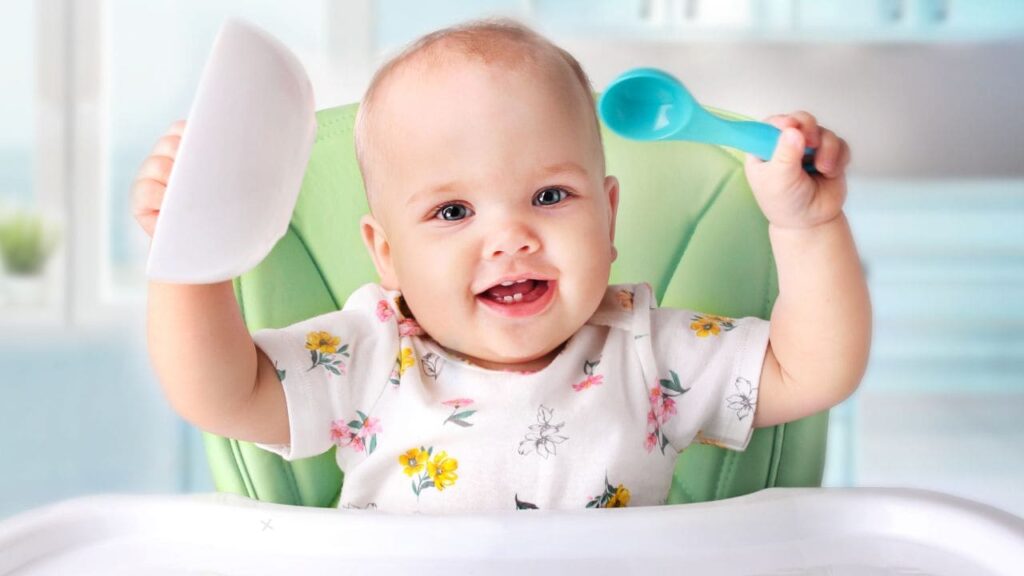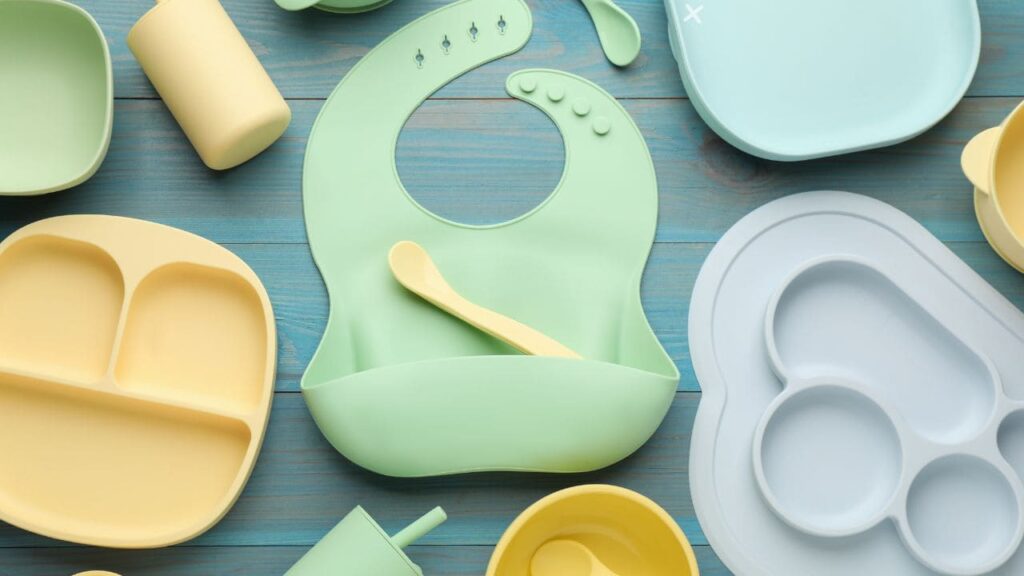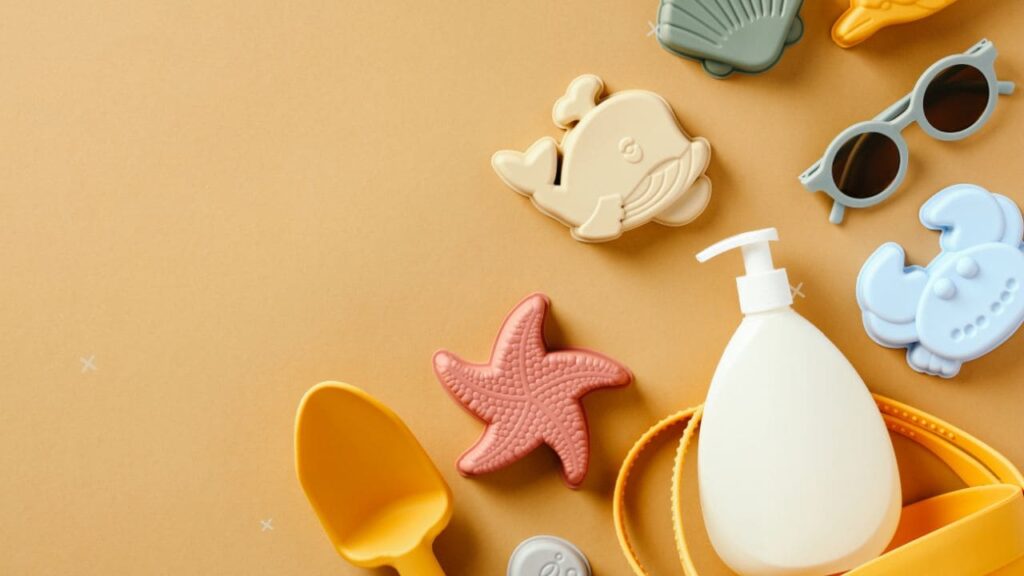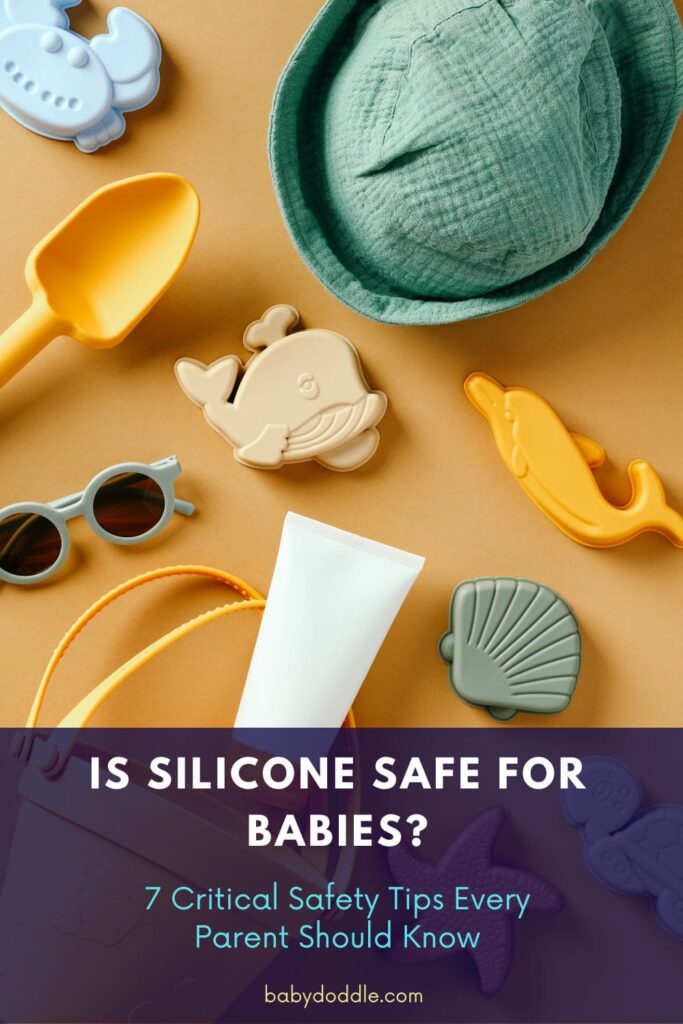As a parent, ensuring your baby’s safety and well-being is of utmost importance. With so many products available in the market, it’s natural to wonder about the materials they’re made of and whether they’re safe for your little one. One material that has gained popularity in recent years for baby products is silicone. But is silicone safe for babies? Let’s dive into this topic and explore seven critical safety tips every parent should know.

What is Silicone and Why is it Used for Baby Products?
Silicone is a synthetic rubber-like material made by bonding silicon and oxygen atoms together. It’s a versatile substance that’s known for its durability, flexibility, and heat resistance. These properties make silicone an ideal choice for a wide range of baby products, including:
- Bottles and sippy cups
- Pacifiers and teething toys
- Bibs and dishware
- Bath toys and accessories
One of the main reasons silicone is favored for baby products is that it’s considered safe for food contact. In fact, the U.S. Food and Drug Administration (FDA) has approved the use of specific grades of silicone in food-related applications.
Is Silicone Safe for Babies?
While silicone is generally regarded as safe for babies, there have been some concerns raised about the potential for chemical leaching or allergic reactions. Let’s address these concerns:
- Chemical Leaching: High-quality, food-grade silicone is considered non-toxic and safe for babies when used as intended. However, it’s important to note that silicone products can degrade and potentially release chemicals if exposed to excessive heat or harsh conditions. This is why it’s crucial to follow the manufacturer’s instructions and avoid exposing silicone products to extreme temperatures or corrosive substances.
- Allergic Reactions: While rare, some babies may have an allergic reaction to silicone. Symptoms of an allergic reaction can include rashes, hives, or swelling. If you notice any of these signs, it’s best to discontinue using the silicone product and consult your pediatrician.
Overall, reputable organizations like the FDA, Health Canada, and the European Food Safety Authority have deemed silicone safe for use in baby products when it meets the appropriate safety standards.
It’s worth mentioning that historical concerns about chemicals in everyday products have led to increased scrutiny and stricter regulations regarding materials used in consumer goods, especially those intended for children.
Common Misconceptions About Silicone Safety
While silicone is generally considered safe for babies, there are some common misconceptions that can cause unnecessary concern. Let’s address a few of them:
- Silicone is the same as plastic: This is a common misunderstanding. While both silicone and plastic are synthetic materials, they have very different chemical compositions and properties. Silicone is made from silicon and oxygen, while plastics are typically derived from petroleum-based sources.
- Silicone products contain BPA or phthalates: High-quality silicone products from reputable brands are free from harmful chemicals like BPA (bisphenol A) and phthalates. However, it’s always a good idea to check the labels and certifications to ensure that the products you’re purchasing are indeed BPA- and phthalate-free.
- Silicone is unsafe for microwaving or dishwashing: While it’s best to avoid exposing silicone to extremely high temperatures, most silicone products are safe for microwaving and dishwashing when used according to the manufacturer’s instructions. Always check the product labels for specific guidelines.
By addressing these common misconceptions, you can make more informed decisions and feel confident in using silicone products for your baby.
Types of Silicone and the Importance of Purity
Not all silicone products are created equal. There are different grades of silicone, each with varying levels of purity and intended uses. When it comes to baby products, it’s crucial to choose items made from high-quality, food-grade silicone that meets safety standards.
Additionally, some silicone products, particularly those with bright colors, may contain trace amounts of lead or other heavy metals. While the levels are typically low and within acceptable limits, it’s always a good idea to look for products that have been tested and certified as lead-free or heavy metal-free.
7 Critical Safety Tips for Using Silicone Baby Products
- Check for Safety Certifications: When purchasing silicone baby products, look for trusted brands that clearly display safety certifications like FDA approval, BPA-free, phthalate-free, and lead-free labels. These certifications ensure that the products meet strict safety standards and are free from harmful substances.
- Inspect for Damage Regularly: Silicone is durable, but it can still become damaged over time. Regularly inspect your silicone products for any cracks, tears, or rough edges that could pose a choking hazard or cause injury to your baby. If you notice any damage, it’s best to replace the product immediately.
- Avoid Excessive Heat Exposure: While silicone is heat-resistant, exposing it to excessive heat can cause degradation and potentially release chemicals. Avoid boiling, baking, or running silicone products through the dishwasher on the highest heat settings. Follow the manufacturer’s instructions for safe cleaning and usage temperatures.
- Replace Products Periodically: Even with proper care, silicone products can wear down over time. It’s a good idea to replace heavily used items like bottles, pacifiers, and teething toys every 6 to 12 months to ensure they remain safe and hygienic for your baby.
- Clean Properly After Each Use: Proper cleaning is essential to maintain the safety and longevity of silicone products. Use mild soap and warm water to clean them after each use. Avoid using harsh cleaning agents or abrasive sponges, as they can break down the silicone material over time.
- Watch for Allergic Reactions: While rare, some babies may exhibit signs of an allergic reaction to silicone, such as rashes, hives, or swelling. If you notice any of these symptoms, discontinue using the silicone product immediately and consult your pediatrician.
- Supervise Use, Avoid Misuse: Always supervise your baby when they’re using silicone products, and ensure they’re being used as intended. Prevent your little one from excessively biting, chewing, or misusing the products, as this could lead to damage or potential choking hazards.

Silicone vs. Other Baby-Safe Materials
While silicone is a popular and generally safe choice for baby products, it’s not the only safe material option available. Here’s a quick comparison of silicone with other commonly used materials:
- Glass: Glass is a non-toxic and inert material that’s incredibly durable and easy to clean. However, it can be heavy and prone to breaking if dropped, making it less suitable for certain applications like sippy cups or baby bottles.
- Stainless Steel: Stainless steel is another safe and durable option for baby products. It’s resistant to rust, easy to clean, and doesn’t leach chemicals. However, it can be more expensive and may not be as lightweight or flexible as silicone.
- Bamboo or Wood: Natural materials like bamboo and wood are eco-friendly and safe for babies when properly treated and finished. They’re often used for toys, dishes, and utensils. However, they may require more maintenance and can be prone to splintering or cracking over time.
- Plastic (BPA-free and phthalate-free): While plastic has historically raised concerns, there are now many BPA-free and phthalate-free plastic options available for baby products. These are generally considered safe when used as intended, but they may not be as durable or eco-friendly as silicone.
Ultimately, the choice of material will depend on your preferences, budget, and specific product needs. It’s always a good idea to research and compare the pros and cons of each material before making a decision.
| Material | Pros | Cons |
|---|---|---|
| Silicone | Durable, flexible, easy to clean, heat-resistant | Non-biodegradable, can degrade at high temps |
| Glass | Non-toxic, durable, easy to clean | Heavy, breakable |
| Stainless Steel | Rust-resistant, durable, easy to clean | More expensive, not as flexible |
| Bamboo/Wood | Natural, eco-friendly | Requires more maintenance, can splinter |
| BPA-free Plastic | Lightweight, affordable | Not as durable, less eco-friendly |
Environmental Considerations of Silicone
One of the advantages of silicone is its reusability and eco-friendliness. Unlike disposable plastic products, high-quality silicone items can be used repeatedly, reducing waste and minimizing your environmental impact.
However, it’s important to note that silicone is not biodegradable. While it’s a more sustainable option than single-use plastics, silicone products will eventually need to be disposed of properly at the end of their lifespan.
Silicone and Sustainability: An Eco-Friendly Choice?
As more consumers become environmentally conscious, the question of silicone’s sustainability often arises. Here’s a closer look at the eco-friendly aspects of silicone:
- Durability and Reusability: One of the most significant advantages of silicone is its durability and reusability. Unlike disposable plastics, silicone products can be used repeatedly, reducing waste and minimizing your environmental impact.
- Non-Toxic and Safe: Silicone is a non-toxic material that doesn’t contain harmful chemicals like BPA or phthalates. This makes it a safer choice for the environment and for your family’s health.
- Recyclability: While silicone itself is not biodegradable, it is recyclable in many areas. Check with your local recycling facility to see if they accept silicone products for recycling.
- Energy Efficiency: The production of silicone products generally requires less energy and generates fewer emissions compared to some other materials, making it a more eco-friendly choice.
- Longevity: With proper care and maintenance, high-quality silicone products can last for years, reducing the need for frequent replacements and minimizing waste.
While silicone may not be a perfect eco-friendly solution, it offers several advantages over traditional plastics and can be a more sustainable choice when used responsibly and disposed of properly at the end of its lifespan.
Safe Usage of Silicone Products
When it comes to using silicone products for your baby, there are a few guidelines to keep in mind:
- Cooking/Baking: While silicone is heat-resistant, it’s generally best to minimize or avoid using silicone bakeware, molds, or utensils at extremely high temperatures (above 400°F or 200°C). Excessive heat can cause the silicone to degrade and potentially release chemicals.
- Mealtime and Drinks: Silicone plates, cups, bowls, and bibs are considered safe for your baby’s mealtimes and drinks. Just be sure to follow the manufacturer’s instructions for proper use and cleaning.
- Play: Silicone toys and teethers provide a safer alternative to plastic toys, as they’re more durable and less likely to contain harmful chemicals like BPA or phthalates.
If you’re concerned about using silicone products, there are other safe materials to consider for your baby’s items, such as glass, stainless steel, or wooden toys.
Personal Recommendations and Alternatives
In my household, we’ve had great experiences using silicone products for our little ones. Our favorite items include silicone bibs (they catch spills so well!), sippy cups (no more broken cups!), and bath toys (easy to clean and mold-resistant).
That being said, we also incorporate other safe materials like stainless steel bottles and bowls, as well as wooden toys for added variety and peace of mind.
Benefits of Using Silicone for Babies
Beyond its safety, silicone offers several advantages that make it a popular choice for baby products:
- Durability: Silicone is incredibly durable and can withstand drops, bites, and general wear and tear better than many other materials.
- Easy to Clean: Silicone is non-porous, which means it doesn’t harbor bacteria or absorb odors and stains. It’s also dishwasher-safe, making it a low-maintenance option for busy parents.
- Affordable: Compared to materials like glass or stainless steel, silicone products are often more affordable, making them accessible to a wider range of families.
Silicone Safety in the Kitchen: Bakeware and Utensils
While silicone is often recommended for baby products, it’s also becoming increasingly popular in the kitchen for bakeware and utensils. But is it safe to use silicone for cooking and baking? Let’s explore:
- Silicone Bakeware: Silicone bakeware, such as molds, mats, and baking sheets, is generally safe for oven use up to temperatures around 400°F (204°C). However, it’s important to follow the manufacturer’s instructions and avoid exposing the silicone to extreme or prolonged heat, as this can cause degradation and potential chemical leaching.
- Silicone Utensils: Silicone spatulas, whisks, and other kitchen utensils are safe for use with both hot and cold foods. They are heat-resistant and won’t scratch non-stick cookware, making them a convenient choice for everyday cooking.
- Precautions: While silicone is considered safe for most kitchen applications, it’s still essential to take some precautions. Avoid using silicone bakeware or utensils that show signs of damage or degradation, as this can increase the risk of chemical leaching. Additionally, it’s best to avoid exposing silicone to direct flames or broiler settings, as the high heat can cause it to degrade more quickly.
By following these guidelines and exercising caution when using silicone in the kitchen, you can enjoy the convenience and versatility of silicone bakeware and utensils while minimizing any potential safety risks.
Signs of Unsafe Silicone and When to Discard
Even with the best care, silicone products can degrade over time. Here are some signs that indicate it’s time to discard a silicone item:
- Severe Discoloration: If a silicone product has become significantly discolored, it may be a sign that it’s breaking down and potentially releasing chemicals.
- Strong Chemical Smell: A strong, persistent chemical odor emanating from a silicone product is a red flag and may indicate that it’s no longer safe to use.
- Brittleness or Cracking: If a silicone item has become brittle, cracked, or otherwise damaged, it’s time to replace it, as it could pose a choking or injury hazard.
Remember, it’s always better to err on the side of caution when it comes to your baby’s safety. If you have any doubts about the condition of a silicone product, it’s best to discard it and replace it with a new, safe item.

Choosing the Right Silicone Products for Your Baby
When shopping for silicone baby products, it’s essential to choose high-quality items from trusted brands. Here are some tips to help you make the right choices:
- Read product labels and certifications: Look for products that are clearly labeled as food-grade, BPA-free, phthalate-free, and lead-free. Certifications from reputable organizations like the FDA or CPSC (Consumer Product Safety Commission) can provide additional assurance.
- Check for safety recalls: Before making a purchase, quickly check if the product has been subject to any safety recalls or warnings from the manufacturer or regulatory bodies.
- Consider the brand reputation: Opt for well-known, reputable brands that have a track record of producing safe and high-quality silicone products for babies.
- Inspect the product: Once you’ve purchased a silicone item, thoroughly inspect it for any defects, rough edges, or strong chemical odors before using it with your baby.
By being a discerning consumer and doing your due diligence, you can ensure that the silicone products you bring into your home are safe for your little one.
Conclusion: Using Silicone Safely for Baby’s Health
In conclusion, silicone is generally considered a safe material for baby products when used correctly and when adhering to safety guidelines. By following the seven critical safety tips outlined in this article, you can ensure that your little one stays safe while enjoying the benefits of silicone products.
Remember to prioritize your baby’s safety by choosing high-quality, undamaged silicone products from trusted brands, and don’t hesitate to explore alternative materials if you have any concerns. With proper care and vigilance, silicone can be a practical and safe choice for your baby’s needs.
As with any product, it’s essential to stay informed about the latest research and recommendations regarding silicone safety. By staying up-to-date and making informed decisions, you can provide a safe and nurturing environment for your precious little one.
FAQ – Is Silicone Safe for Babies?
How can I tell if a silicone product is safe for my baby?
Look for silicone products that clearly display safety certifications like FDA approval, BPA-free, phthalate-free, and lead-free labels. These certifications ensure that the products meet strict safety standards and are free from harmful substances. Additionally, choose items from reputable brands with a track record of producing high-quality, safe silicone products for babies.
Is it safe to microwave or dishwash silicone baby products?
Most silicone products are safe for microwaving and dishwashing when used according to the manufacturer’s instructions. However, it’s best to avoid exposing silicone to extremely high temperatures, such as the sanitize or high-heat cycle in the dishwasher, as this can cause degradation and potential chemical leaching. Always check the product labels for specific guidelines on safe temperature ranges.
How often should I replace silicone baby bottles, pacifiers, and toys?
It’s generally recommended to replace heavily used silicone products like bottles, pacifiers, and teething toys every 6 to 12 months. This is because silicone can wear down over time, potentially becoming damaged or less safe. For pacifiers, replacement may be needed more frequently, around every 4 to 6 weeks for heavy use, as they are constantly in a baby’s mouth and subject to more wear and tear.
Are there alternatives to silicone that are safe for babies?
Yes, there are several other safe materials to consider for baby products, including glass, stainless steel, bamboo or wood, and BPA-free plastics. Each material has its own pros and cons in terms of durability, cost, eco-friendliness, and ease of use. It’s important to research and compare the options to find the best fit for your preferences and needs.
Is silicone an eco-friendly choice for baby products?
Silicone can be considered a more eco-friendly option compared to single-use plastics, as it is durable and can be reused repeatedly, reducing waste. However, silicone is not biodegradable, so proper disposal is important once the products reach the end of their lifespan. Many silicone products can be recycled, but it’s best to check with your local recycling facility for specific guidelines.












